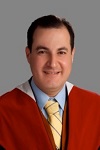
Hamzah Al-Qadiri
The University of Jordan, Jordan
Title: Efficacy of acidic and alkaline electrolyzed water for inactivating Escherichia coli O104:H4, Listeria monocytogenes, Campylobacter jejuni, Aeromonas hydrophila, and Vibrio parahaemolyticus in cell suspensions
Biography
Biography: Hamzah Al-Qadiri
Abstract
This study investigated the effect of electrolyzed water on pathogenic bacteria cell suspensions. Specifically, we evaluated the efficacy of strong and weak acidic electrolyzed waters (SACEW, WACEW) and strong and weak alkaline electrolyzed waters (SALEW, WALEW) on Vibrio parahaemolyticus, Listeria monocytogenes, Aeromonas hydrophila, Campylobacter jejuni, and Escherichia coli O104:H4 in suspensions of (107-109 CFU/mL) in 1% NaCl. SACEW and WACEW were applied at available chlorine concentrations (ACC) of 20 and 10 mg/L, pH 3.1 and 3.55 and oxidation-reduction potentials (ORP) of 1150 and 950 mV, respectively. Results show that no viable cells were recovered for V. parahaemolyticus, L. monocytogenes, A. hydrophila, C. jejuni within 2 min at 20 °C. However, E. coli O104:H4 was significantly more resistant to ALEW compared to ACEW. Results also show that the bactericidal activity of SACEW (20 mg/L ACC) was more effective than WACEW (10 mg/mL ACC) in terms of inactivating E. coli O104:H4. Alkaline electrolyzed waters were found to reduce cell numbers by 1-3 log (P < 0.05). However, alkaline electrolyzed water was less effective (P < 0.05) than acidic electrolyzed treatment.
